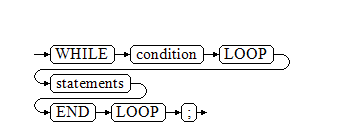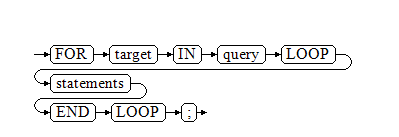循环语句
简单LOOP语句
语法图

label declaration ::=

示例
1 2 3 4 5 6 7 8 9 10 11 12 13 14 15 16 17 18 19 20 21 22 |
gaussdb=# CREATE OR REPLACE PROCEDURE proc_loop(i in integer, count out integer) AS BEGIN count:=0; LOOP IF count > i THEN raise info 'count is %. ', count; EXIT; ELSE count:=count+1; END IF; END LOOP; END; / CREATE PROCEDURE gaussdb=# CALL proc_loop(10,5); INFO: count is 11. count ------- 11 (1 row) |

该循环必须要结合EXIT使用,否则将陷入死循环。
WHILE_LOOP语句
语法图

label declaration ::=

只要条件表达式为真,WHILE语句就会不停地在一系列语句上进行循环,在每次进入循环体的时候进行条件判断。
示例
1 2 3 4 5 6 7 8 9 10 11 12 13 14 15 16 17 18 19 20 21 22 23 24 25 26 27 |
gaussdb=# CREATE TABLE integertable(c1 integer) ; CREATE TABLE gaussdb=# CREATE OR REPLACE PROCEDURE proc_while_loop(maxval in integer) AS DECLARE i int :=1; BEGIN WHILE i < maxval LOOP INSERT INTO integertable VALUES(i); i:=i+1; END LOOP; END; / CREATE PROCEDURE --调用存储过程 gaussdb=# CALL proc_while_loop(10); proc_while_loop ----------------- (1 row) --删除存储过程和表 gaussdb=# DROP PROCEDURE proc_while_loop; DROP PROCEDURE gaussdb=# DROP TABLE integertable; DROP TABLE |
FOR_LOOP(integer变量)语句
语法图

label declaration ::=


- 变量name会自动定义为integer类型并且只在此循环里存在。变量name介于lower_bound和upper_bound之间。
- 当使用REVERSE关键字时,lower_bound必须大于等于upper_bound,否则循环体不会被执行。
示例
1 2 3 4 5 6 7 8 9 10 11 12 13 14 15 16 17 18 19 20 21 22 23 24 25 26 27 |
--从0到5进行循环 gaussdb=# CREATE OR REPLACE PROCEDURE proc_for_loop() AS BEGIN FOR I IN 0..5 LOOP DBE_OUTPUT.PRINT_LINE('It is '||to_char(I) || ' time;') ; END LOOP; END; / CREATE PROCEDURE --调用存储过程 gaussdb=# CALL proc_for_loop(); It is 0 time; It is 1 time; It is 2 time; It is 3 time; It is 4 time; It is 5 time; proc_for_loop --------------- (1 row) --删除存储过程 gaussdb=# DROP PROCEDURE proc_for_loop; DROP PROCEDURE |
FOR_LOOP查询语句
语法图

label declaration ::=


- 变量target会自动定义,类型和query的查询结果的类型一致,并且只在此循环中有效。target的取值就是query的查询结果。
- query可以使用EXECUTE增加动态查询,通过USING向查询插入参数。详见示例中的动态查询相关内容。
1 2 3 4 5 6 7 8 9 10 11 12 13 14 15 16 17 18 19 20 21 22 23 24 25 26 27 28 29 30 31 32 33 34 35 36 37 38 39 40 41 |
--循环输出查询结果。 gaussdb=# CREATE OR REPLACE PROCEDURE proc_for_loop_query() AS record VARCHAR2(50); BEGIN FOR record IN SELECT spcname FROM pg_tablespace LOOP dbe_output.print_line(record); END LOOP; END; / CREATE PROCEDURE --调用存储过程 gaussdb=# CALL proc_for_loop_query(); pg_default pg_global proc_for_loop_query --------------------- (1 row) --删除存储过程 gaussdb=# DROP PROCEDURE proc_for_loop_query; DROP PROCEDURE --动态查询 gaussdb=# CREATE TABLE t1(id int); gaussdb=# INSERT INTO t1 VALUES(1); gaussdb=# DECLARE a int := 1; item t1%rowtype; BEGIN FOR item IN EXECUTE 'SELECT * FROM t1 WHERE id = :1' USING a LOOP RAISE INFO '%', item; END LOOP; END; / INFO: (1) ANONYMOUS BLOCK EXECUTE gaussdb=# DROP TABLE t1; |
FORALL批量查询语句
语法图

label declaration ::=


- 变量index会自动定义为integer类型并且只在此循环里存在。index的取值介于low_bound和upper_bound之间。
- 如果声明了SAVE EXCEPTIONS,则会将循环体DML执行过程中每次遇到的异常保存在SQL%BULK_EXCEPTIONS中,并在执行结束后统一抛出一个异常,循环过程中没有异常的执行的结果在当前子事务内不会回滚。
- 使用FORALL + BULK COLLECT INTO时,INTO的变量仅返回单条DML语句执行结果。
示例
1 2 3 4 5 6 7 8 9 10 11 12 13 14 15 16 17 18 19 20 21 22 23 24 25 26 27 28 29 30 31 32 33 34 35 36 37 38 39 40 41 42 43 |
gaussdb=# CREATE TABLE hdfs_t1 ( title NUMBER(6), did VARCHAR2(20), data_period VARCHAR2(25), kind VARCHAR2(25), interval VARCHAR2(20), time DATE, isModified VARCHAR2(10) ); CREATE TABLE gaussdb=# INSERT INTO hdfs_t1 VALUES( 8, 'Donald', 'OConnell', 'DOCONNEL', '650.507.9833', to_date('21-06-1999', 'dd-mm-yyyy'), 'SH_CLERK' ); INSERT 0 1 gaussdb=# CREATE OR REPLACE PROCEDURE proc_forall() AS BEGIN FORALL i IN 100..120 update hdfs_t1 set title = title + 100*i; END; / CREATE PROCEDURE --调用存储过程 gaussdb=# CALL proc_forall(); proc_forall ------------- (1 row) --查询存储过程调用结果 gaussdb=# SELECT * FROM hdfs_t1; title | did | data_period | kind | interval | time | ismodified --------+--------+-------------+----------+--------------+---------------------+------------ 231008 | Donald | OConnell | DOCONNEL | 650.507.9833 | 1999-06-21 00:00:00 | SH_CLERK (1 row) --删除存储过程和表 gaussdb=# DROP PROCEDURE proc_forall; DROP PROCEDURE gaussdb=# DROP TABLE hdfs_t1; DROP TABLE |






